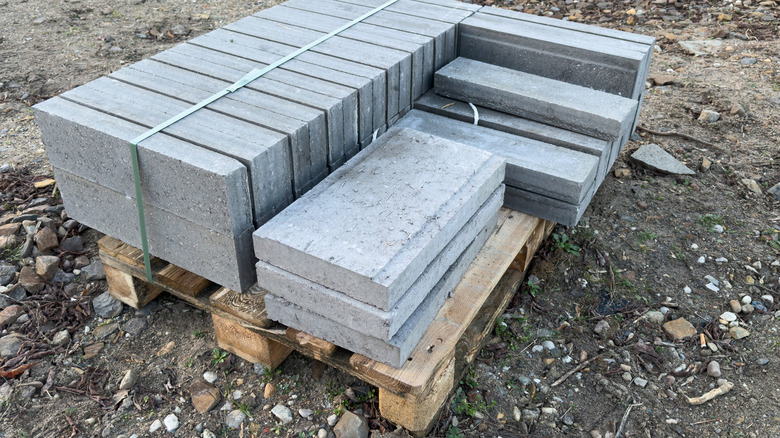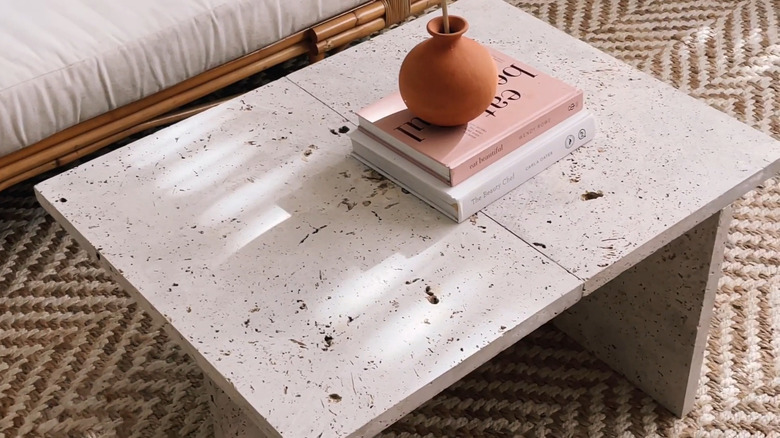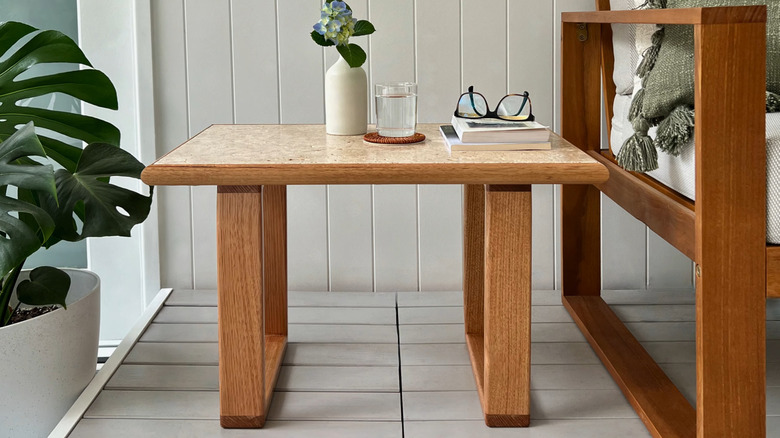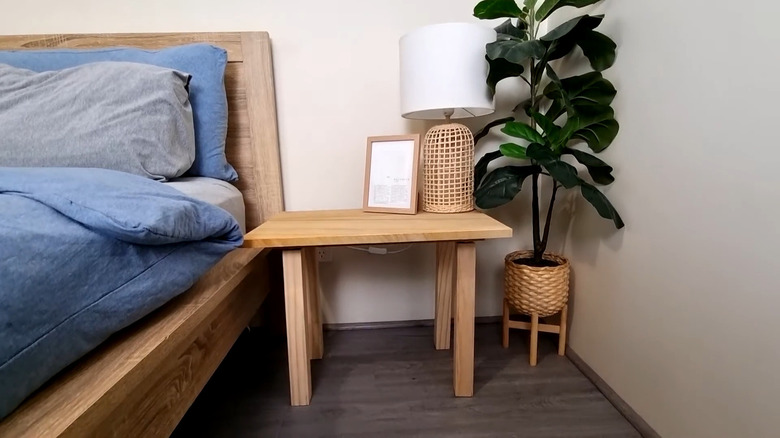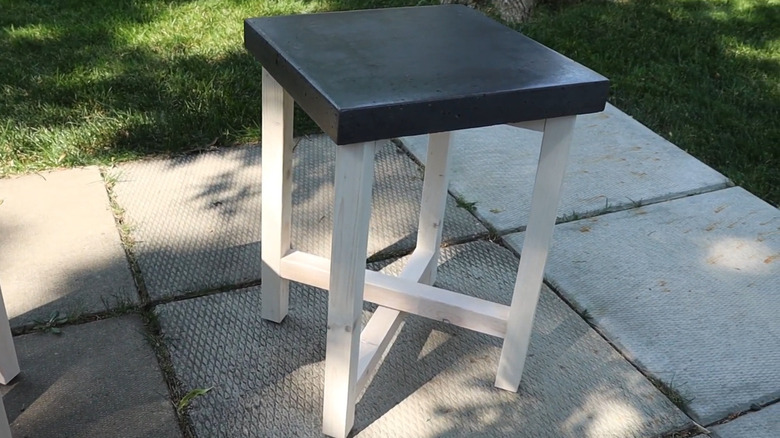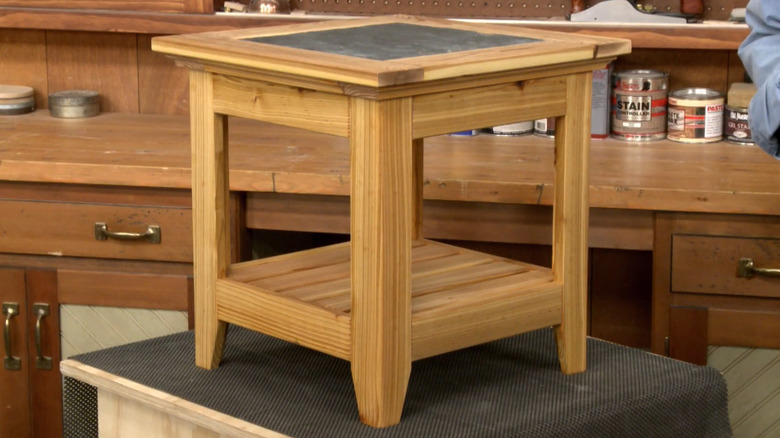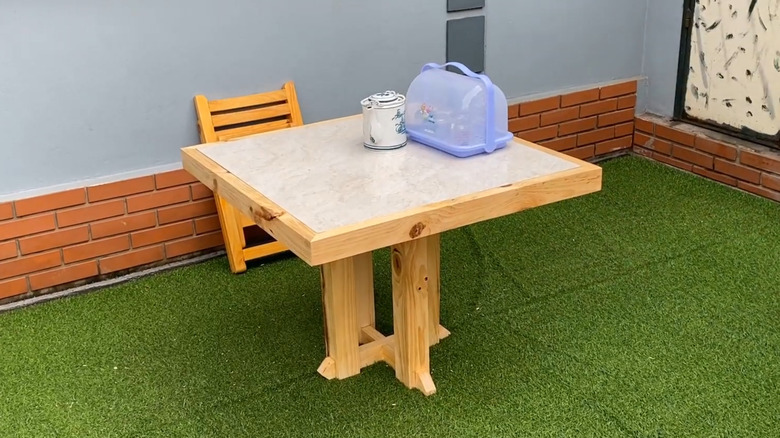Turn Pavers Into Stylish Tables With These 8 Clever Upcycle Ideas
Even the simplest side table can have a lot of character, and that character comes from a surprising number of subtleties. A table's base can drive its stability, function, and style, but a tabletop is usually the defining feature of a table. The trouble is that many tabletops simply aren't that easy to DIY. A rustic farmhouse table, for example, will have you wishing for a planer, a biscuit jointer, and access to better distressed barnwood. But there's one way you can make a small (or even not-so-small) table that's durable and stylish, but with all the tabletop-creation work already done for you — the humble paver.
Pavers can be made from concrete, clay (think bricks), natural stone like flagstone or granite, and occasionally porcelain. They're often inexpensive and usually durable, given that they're designed to weather the weather and handle foot traffic to boot. You can commonly find them as large as 12x24 inches, or as small as 8x8. But the important part is that they usually look great, and can be incorporated into a table design with little or no shaping and finishing.
Travertine side table
Travertine is a sedimentary rock formed from calcium carbonate deposits. It's a form of limestone, though travertine is typically less expensive than limestone. It's also the most popular paver for DIY side tables. One such table was made by YouTuber Geneva Vanderzeil (@GenevaVanderzeil) with three travertine pavers glued together to form a T shape. The third is balanced (and also glued, of course) on the top. Take care to keep the polished side of the travertine visible, and use a strong construction adhesive like Selley's Hold Up or Liquid Nails to keep things together permanently.
Travertine and wood table
Of course, a travertine tabletop doesn't have to have a travertine base, as proven by Natasha Dickins (@littleredindustries), a YouTuber and DIYer with serious woodworking skills. Dickins cleans, rinses, and seals her paver, then frames it using a half round moulding about the same diameter as the paver. (The moulding looks like oak.) Wood is assembled into two rectangles to form the table's base, then rounded over, sanded, and varnished. The base of this travertine table is, like Vanderzeil's, also attached with construction adhesive, using weights to improve the bond.
Paver table with Adoored legs
If you've ever DIYed a table without much of a plan or much in the way of engineering intuition, you've likely created a wobbly and perhaps downright unstable hazard. This usually comes in the form of weakly sticking four legs onto a tabletop, only to learn that this is not a particularly strong arrangement. Adoored makes sturdy prefab legs and leg plates, which they show off in this YouTube video. Their legs and some MDF form a table, then a paver is glued to the top and felt pads are added to the bottom.
Indoor/outdoor simple paver (or concrete) tables
Of course, when you DIY your own legs, you can get as inventive as you want with them. YouTuber @JessedoesDIY makes some simple, attractive legs from two wooden frames that cross in an X shape. Because they would otherwise intersect, he places one stretcher higher than the other, which lends the entire assembly a polished look. @JessedoesDIY designed this table for poured concrete, but it would absolutely work with a paver instead. And since the legs are really the star of this show, the paver can afford to be relatively plain.
A more refined paver (or tile) table
Another paver table that was designed as something else (in this case, a tile-topped table), this YouTube project from Woodsmith is just as elaborate as you'd expect. And, as you'd also expect, the wood is the star of the show again. Your paver or tile is framed in boards butt-jointed with pocket holes. The base is made of four frames, with rabbet cut to join shorter and longer sides and give them equal width. Each leg frame has two rails for rigidity, and the taper of the legs reduces their visual weight.
All-concrete paver and edger table
At the other end of the materials spectrum from the Woodsmith table is this project from Instagram maker @crazylifewithlittles. It's made of a 12" x 12" concrete paver and flour concrete scallop edgers. The edgers are arranged in a plus shape to form the base of the paver, and the base is painted. @crazylifewithlittles also demonstrates a version where the pavers are closer together, giving the table more of a monolithic pedestal. Another YouTuber, Jess Carpenter, has a version that uses a round paver for the top.
A more refined paver side table
Marite Sanchez (@maritedoesit on Instagram) made one of the best-looking small paver tables we've seen, and it's relatively simple as well. The tall, narrow table — a paver atop a tall, well-made wooden base — would look at home in a living room or bedroom of any level of refinement. Sanchez hasn't yet written up the project for her blog, but the base appears to be made of four pieces of plywood with matching arches cut out, in addition to a square bit of plywood in the bottom for added stability and a more finished look.
Adapt a DIY tile table to paver dining table
Our final project, from YouTuber @woodworkingskill, was intended for large-format tile, but could easily be adapted by adhering multiple pavers to concrete backer board, MDF, etc. This great-looking table has a trestle-style pedestal base made from four posts. The posts are secured by grooves cut in the posts (like the female part of a bridle joint, but with the cut running across the short dimension of the board), with saddle-crossed boards top and bottom for stability. The tabletop is framed in dimensional lumber to give the piece a finished-looking edge.
